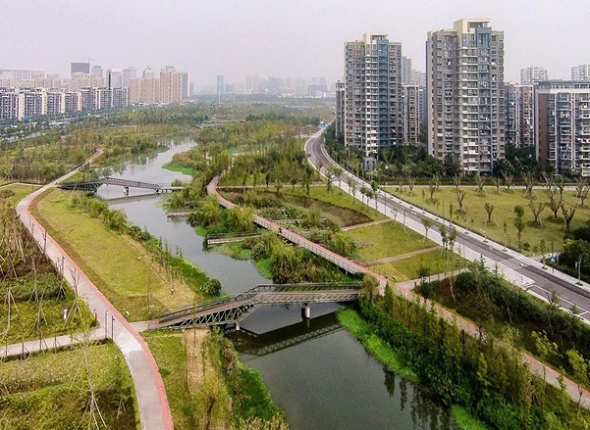Creating sponge cities
By utilising man-made materials like concrete and steel to solve a current problem, we often create further work for humanity down the line. The need for regular repairs, expansion, or total overhauls comes to mind.
Utilising the power of nature, on the other hand, is starting to look like a more sustainable and long-term solution.
This is what Professor Kongjian Yu had in mind when he developed the concept for ‘sponge-cities,’ which – instead of building more stuff to keep out flooding – encourages us to strategically implement foliage and green areas to allow for the absorption of excess water.
‘Though grey infrastructure of concrete, steel, pipes and pumps, can be necessary to solve urgent individual problems, it consumes huge amounts of concrete and energy, lacks resilience and often accumulates a higher risk of disaster.
‘It breaks the connection between man and nature,’ says Yu.

Professor Yu put forward the idea for sponge cities a year after Beijing was devastated by flooding, and has been campaigning for their widespread implementation for over 20 years.
In the Northern China city of Harbin, a 34-hectare ‘stormwater park’ has been trialled successfully. Though it was implemented to collect, cleanse, and store stormwater, it also offers protection to the natural native habitat and provides a green space for the community.
Yu points out that building towns with the inclusion of thousands of plants and numerous wetlands serves to address other climate-related issues. These are included, but not limited to, absorbing air pollution, reducing carbon in the atmosphere, and cooling the city’s air.
The success of the Qunli stormwater park has led the Chinese government to spend around £55 million to implement similar projects in 16 other cities, including Wuhan, Chongqing, and Xiamen.

Creating cities that mitigate the climate crisis
China’s government would do well to embrace these changes too.
At the same time the nation boasts the world’s fastest economic growth, it is also facing challenges such as water shortages in the North and major flooding in the South.
A lack of rain is making pollution worse in major Northern cities, where the bulk of economic development is taking place. This has made the region’s quality of water diminished and unsafe.
Past approaches to water logistics also come into play, as insufficient resource management is only exacerbating the current problem.

When building its water-management systems, the tropical Asian country made the mistake of utilising the blueprints of milder European countries.
By drawing inspiration from nature and looking at China’s unique landscape, Professor Yu’s approach could help to reverse the damages caused by the adoption of a ‘one size fits all’ model and create a system that continuously adapts to the country’s climate.
He explains, ‘Sponge Cities are inspired by the ancient wisdom of farming and water management that use simple tools to transform the global surface at a vast scale in a sustainable way.’
By implementing his idea, Yu hopes to fulfil his goal of seeing ‘a city devoid of grey infrastructure, with wetlands, green areas, permeable surfaces, widespread vegetation, winding creeks, open areas next to roads, and floodplains.’
With over 70 percent of Chinese cities already looking to implement the Sponge City approach by 2030, it looks like China could be protected by harnessing the powers of Mother Nature herself.
























